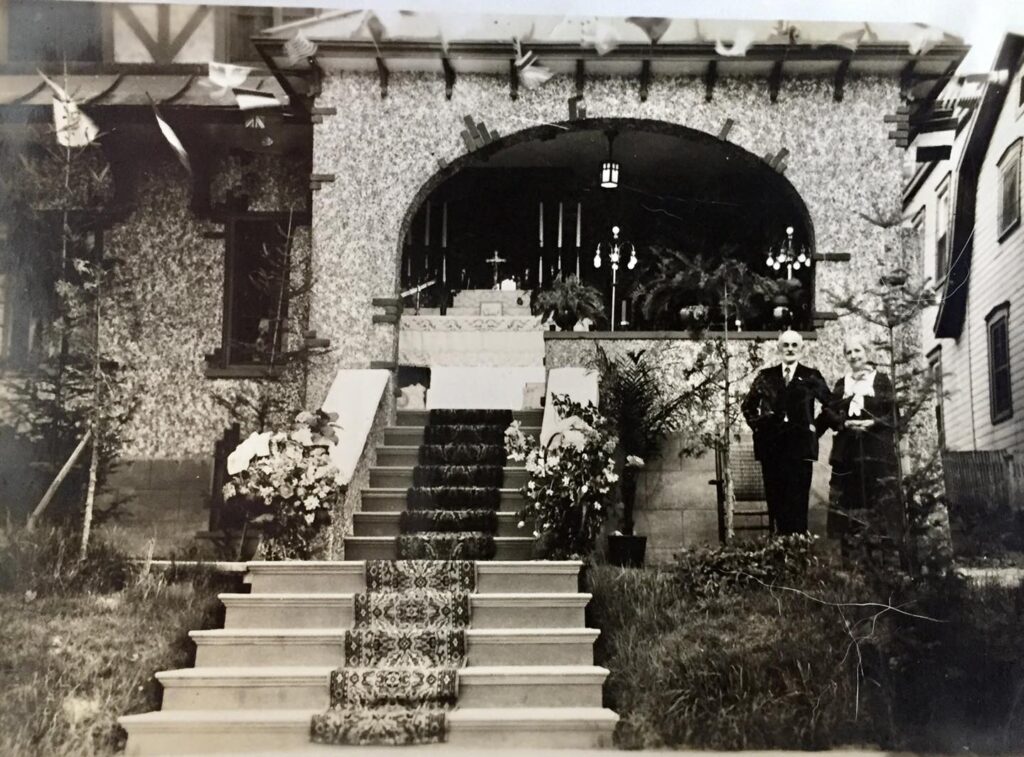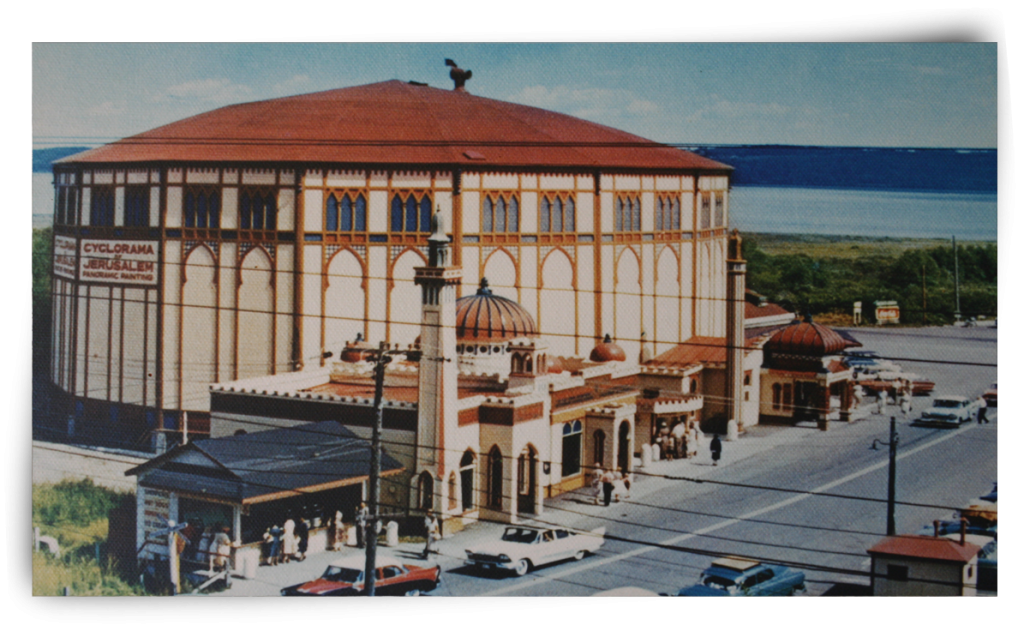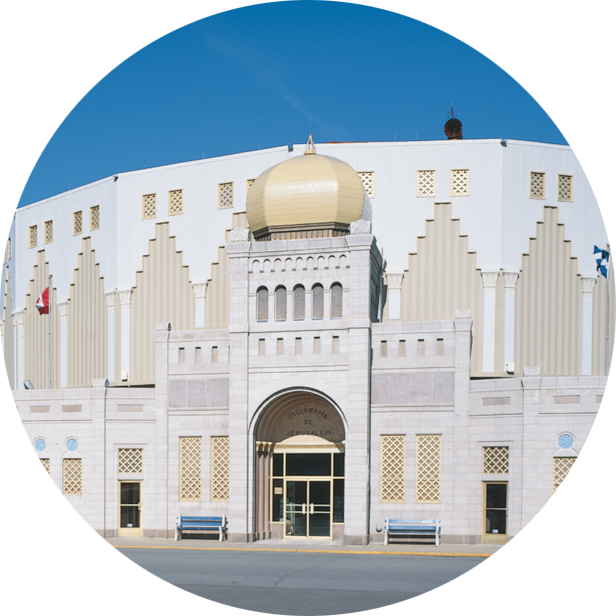
HISTORY
THE CYCLORAMA OF JERUSALEM
was conceived by a prominent German painter from Munich, Bruno Piglhein.
More than a century ago, Piglhein was commissioned by Joseph Halder, a wealthy Munich merchant, to create a large panoramic painting representing the Crucifixion, the city of Jerusalem and the surrounding countryside.
After studying everything available at that time, Piglhein traveled to Jerusalem accompagnied by distinguished collaborators : Josef Block, Johann Adalbert Heine and Josef Krieger. The four men spent an entire year in Jerusalem taking photos and studying the topography, architecture and the lifestyle of the inhabitants.
Back in Germany they created a large panoramic painting which was subsequently exhibited in Munich and Berlin in Germany as well as in Vienna, Austria. Disaster struck in 1892. This large painting burned in a fire in Vienna. Piglhein was deeply distraught.
In 1887 Ernest Pierpont (1854-1905) a Chicago doctor and businessman who had been producing panoramas for several years, equipped himself with Piglhein’s plans and research. He aimed to produce a new panorama entitled “Jerusalem at the Time of the Crucifixion”. With Piglhein’s documentation, Pierpont assembled a team of masterful painters for this endeavor : Oliver Dennett Grover (1861-1927) and Charles Abel Corwin (1857-1938) from Chicago; Salvador Mège (1854-1915) and Ernest Gros (1859-1930) of Paris; and Edward James Austen (1850-1930) of London. Each of these men had contributed to the production of other panorama paintings.
This enormous rolled canvas was shipped from the American studio to Montreal, where visitors could view it from 1889 through 1895. The attraction was located in the heart of downtown, at the corner of Sainte-Catherine and Saint-Urbain streets, where Place des Arts stands today. The building was inaugurated in February 1889.
This new panorama painting “Jerusalem at the Time of the Crucifixion” was displayed in a building on land owned by the Gray Nuns of Montreal. There was a 9-year rental agreement between the nuns and the American owners. However, after 5 years the American compagny was in breach of the contract and the agreement between the two parties ended.
In the spring of 1895, Montreal lawyer Ubald Plourde (1864-1939) purchased the Cyclorama of Jerusalem painting from the Gray Nuns. He and his wife transported the rolled-up artwork to Sainte-Anne-de-Beaupré by boat, right next to Sainte Anne’s Sanctuary, a popular site for both pilgrims and tourists. Ubald was a young lawyer of 31, and Ablina was almost 26. They settled in Sainte-Anne-de-Beaupré, on Avenue Royale, not far from their new project. His wife, Albina Laurendeau-Plourde (1869-1964), would later become the sole owner of the Cyclorama in 1939 upon the death of her husband.
Ubald Plourde and Albina Laurendeau-Plourde, Cyclorama owners in front of their home on Avenue Royale, Sainte-Anne-de-Beaupré, circa 1930.
However, on May 10, 1895, just shortly before the artwork was transported to its new location, the “building collapsed unfer the force of the wind” as reported by a local newspaper. Fortunately, two art works were already safely packed for transport : the panorama painting Jerusalem at the Time of the Crucifixion and Custer’s Last Stand, depicting the Battle of Little Bighorn. The young couple therefore and a new polygonal building constructed on stilts to house the panoramic painting in Sainte-Anne-de-Beaupré, 300km north-east of Montréal and just 30km north-east of Québec City.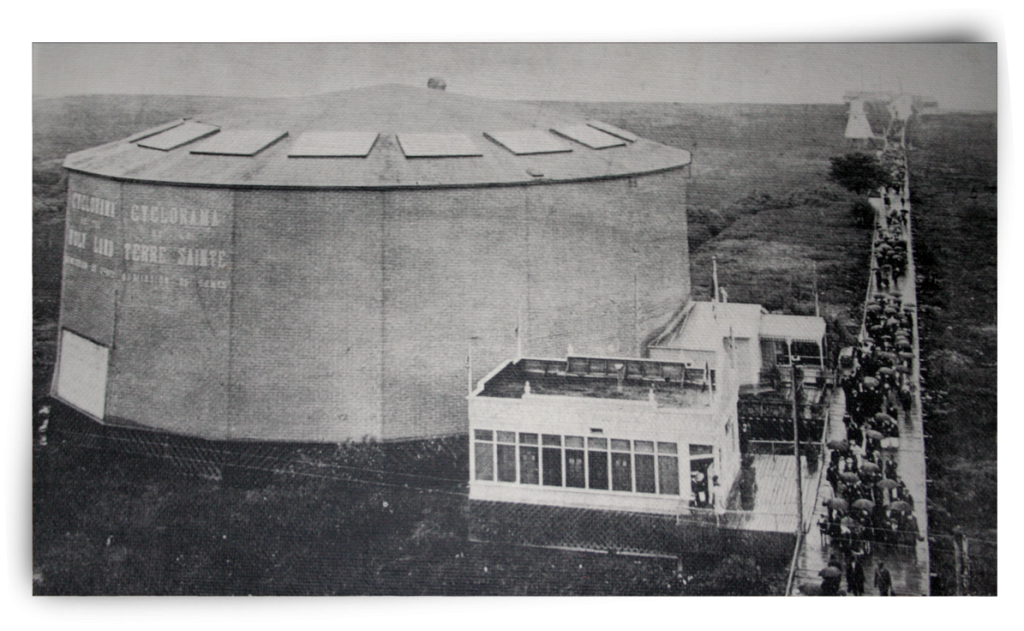
The Cyclorama of Jerusalem as originally built on stilts, Sainte-Anne-de-Beaupré, Québec, Canada, circa 1895.
Between 1925 and 1927 Ms. Laurendeau-Plourde commissioned additional outer-buildings and exterior details to be constructed in an Byzantium style, based on the plans of architect Raoul Chênevert.
In 1949, Georges-Henri Blouin, a loyal employee of the Cyclorama for several years, signed an acquisition agreement with Ms. Laurendeau-Plourde. In 1957 the Blouin family took possession, and the corporation Cyclorama de Jerusalem Inc. was created. That same year, on December 9, 1957, a section of the roof collapsed due to the weight of snow. Along with the roof section, a portion of the observation gallery and a part of the corridor which leads to the observation gallery were also destroyed. A section of the painting was damaged. Construction to reinforce the building was contracted with engineer Oscar Dorval, utilizing plans by Émile-Georges Rousseau. A new, stronger exterior enveloppe was installed for the rotunda, and the entrance pavilion was modified. The plans for the souvenir shop, already under construction since the summer, was expanded.
From March 1958 through September 1959, the Bulgarian-Polish artist Christo Stefanoff (1898-1966) was commissioned to reproduce the damaged portion of the painting. The artist was also asked to modify the faux terrain at the front of the stage. In 1982 steel enamel cladding was added to the rotunda, according to plans by Louis Carrier.
The Cyclorama of Jerusalem with Byzantine detailing, Sainte-Anne-de-Beaupré, Québec, Canada, circa 1950
In August 2017, a classification notice was published by the Quebec Ministry of Culture and Communications to have the Cyclorama recognized as a heritage property. On August 8, 2019, the panorama painting, the polygonal rotunda and the outdoor sign were each classified as protected heritage pieces.
The Cyclorama of Jerusalem closed its doors to the public on October 14, 2018, due to lack of profitability and failure to meet safety standards. Since then, a small committee of generous volunteers came together to assisting the Blouin family to maintain and preserve the building, the souvenir store and the artwork. The Cyclorama reopened its gift shop in 2022 and the rotunda in July 2025.
You can help support the cause of the Cyclorama, assisting in the preservation and conservation of this historical site by clicking here : Give Send Go. All support is greatly appreciated.
Currently, there are three major panoramic paintings representing the Crucifixion in the world : Altötting, Germany; Einsiedeln, Switzerland; and Sainte-Anne-de-Beaupré in Québec, Canada.
Across the globe, there are approximately seventeen cycloramas dating from the 19th and early 20th centuries. “The term cyclorama was coined in the 18th century to designate an extraordinary visual spectacle. A panorama (or cyclorama, as it has been called in some places and times) is a purpose-built architectural structure containing a large 360-degree painting that affords the visual and somatic illusion of standing in the middle of an actual place and/or event. Throughout these efforts, the International Panorama Council strives to connect the past, present and future of the panorama phenomenon worldwide.” – IPC
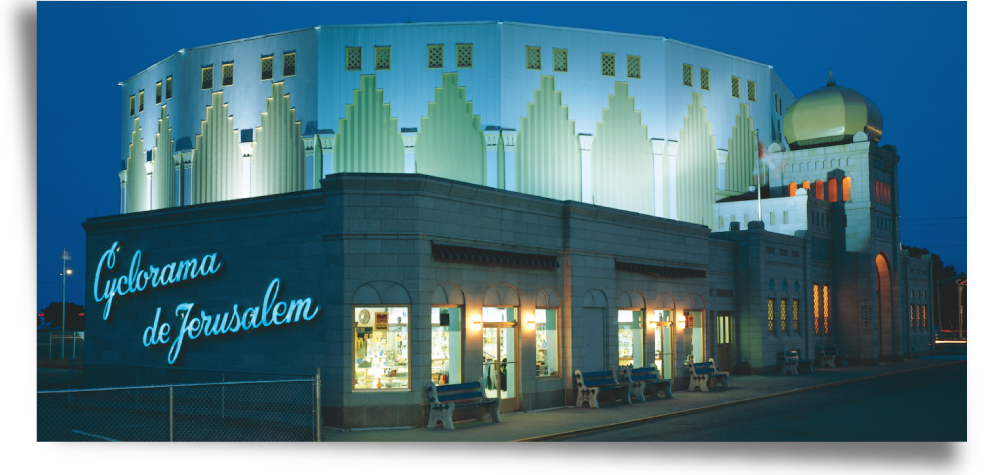
The Cyclorama of Jerusalem, Sainte-Anne-de-Beaupré, Québec, Canada, circa 2016
